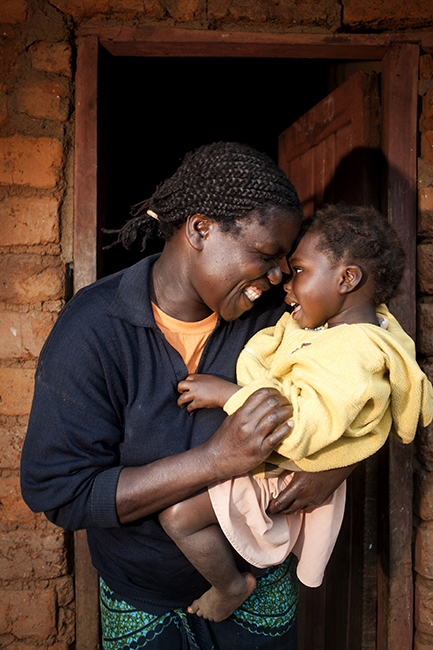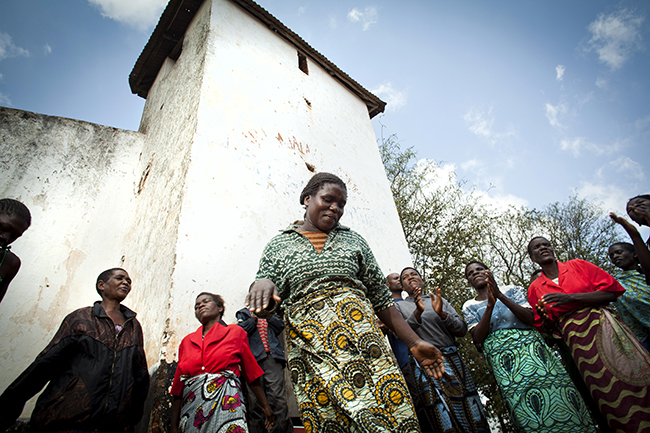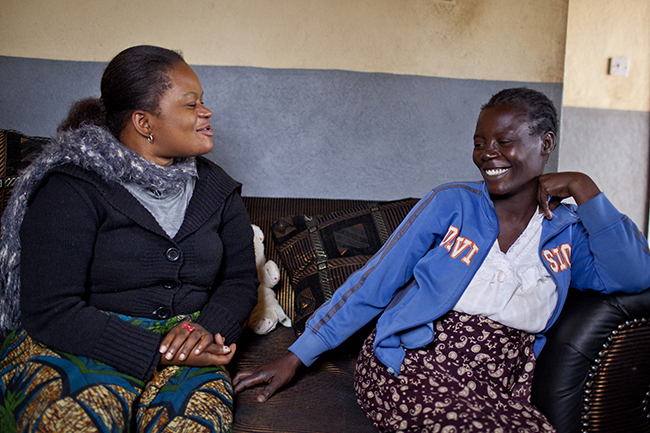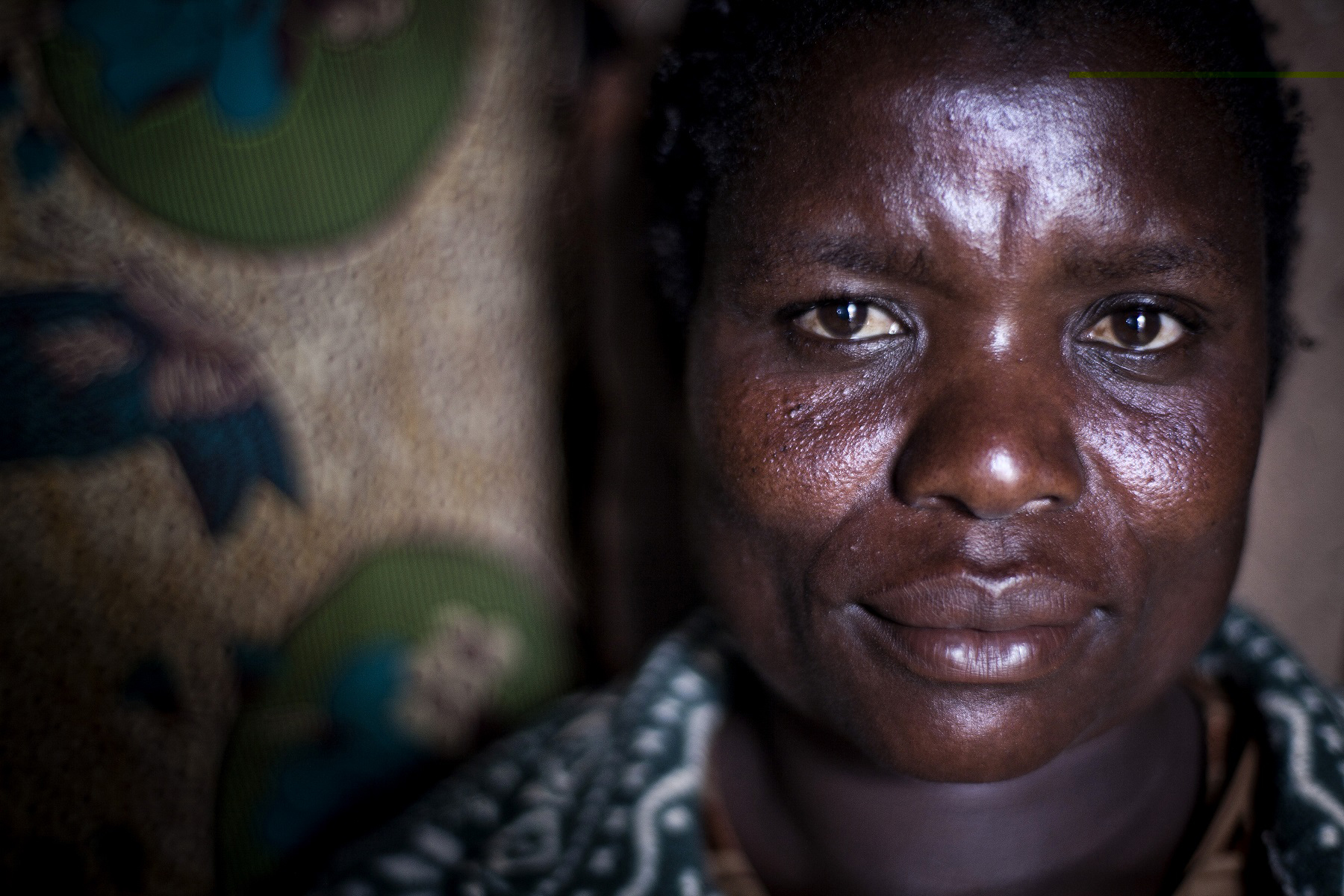
The Evolution
of Preventing
Mother-to-Child
Transmission of HIV

Better Treatment, Same Challenges
By Dr. Helen Bygrave, MBBS, MA, MRCP, MRCGP
One afternoon in 2006, Julia*, 24, somehow found her way to my clinic room in the hospital in Lagos, Nigeria, where MSF was working. She was extremely weak—breathless, dizzy, and coughing. She was also 22 weeks pregnant and alone: her husband had died a month earlier. She had a five-year-old son, but her last two babies had died.
Given Julia’s condition, just getting to the clinic room had been an act of sheer determination. For the past two months, she had been coughing badly and displaying several other symptoms typical of tuberculosis (TB) as well. This was not surprising: people living with HIV without treatment, whose immune systems are deteriorating, are particularly susceptible to opportunistic diseases like TB. Julia was also anemic. After she had learned that she’d tested positive for HIV, the hospital’s antenatal care staff had directed her to MSF’s small HIV clinic in the same building.
We admitted her for a short stay at the hospital to give her a blood transfusion and started her on TB treatment. A few weeks later, we started her on antiretroviral therapy (ART) for HIV. Antiretrovirals had only recently become available in Nigeria, and we could finally provide something beyond treatment for opportunistic diseases and palliative care, which previously had been all we were able to offer. ART had come to be known as the Lazarus treatment because it extended the lives of people carrying the virus. What’s more, it was also proving very effective in preventing mother-to-child transmission (PMTCT) of HIV from pregnant women, like Julia, to their unborn children. Without ART, the mother-to-child transmission rate can be as high as 40 percent. With ART, it can be reduced to less than 5 percent.i
Julia improved quickly. A colleague was in charge of her care, so after those initial visits, I didn’t see her again for five months, until she called out my name in the hospital corridor. She looked so much healthier that I almost didn’t recognize her. And she had a little three-month-old baby on her back who, much to my relief, had tested negative for HIV.
Around the world, HIV affects men and women alike. But in many of the places where MSF works, women are more at risk and more women suffer from the disease. In sub-Saharan Africa, for example, 60 percent of people living with the virus are female. On top of the numerous medical and social challenges women must contend with, they must also worry about transmitting HIV to their unborn babies and breastfeeding infants.
The international community has in recent years made significant progress in PMTCT treatment and strategies. According to the World Health Organization, 900,000 women worldwide received PMTCT in 2012 and coverage for the whole of Africa grew from 13 percent in 2005 to 59 percent in 2011.
At MSF projects, staff provided PMTCT to 18,489 women in 2013.
Currently, MSF treats 341,600 women, men, and children living with HIV
in more than 20 countries.
There is still a long way to go. The WHO also estimates that only 64 percent of the women who need these services in 21 “priority” African countries are actually getting them, and in Southeast Asia, only 16 percent of pregnant women with HIV are receiving PMTCT.ii This shortfall in coverage means that in 2013 some 700 children were newly infected with HIV every day,iii roughly 90 percent of them in sub-Saharan Africa.iv
In Nigeria, six years after Julia got lifesaving treatment for her and her baby, only 17 percent of pregnant women had access to PMTCT.v The message is clear: for every success story like Julia’s, there are many more women who do not get the care they need.
MSF, which began working with people living with HIV in the 1990s, has tried to adapt its programs to extend the reach of HIV care in general and PMTCT care in particular to as many people as possible. One way has been by decentralizing our HIV projects, allowing patients to start treatment at primary care clinics close to where they live rather than requiring them to travel to the nearest hospital, which might be days away. This entails shifting certain tasks from doctors to nurses who are specially trained to initiate ART.
“I have two kids and I am eight months pregnant. The first time I came to MSF, I was sick and pregnant with my second child. I came to get antenatal care and I was referred to get tested. I tested HIV-positive.
I was very afraid when I was told, but there was good counseling and it helped a lot. I accepted my status and started treatment immediately. My first-born is HIV-positive. For my second pregnancy, I really adhered to my treatment. I made sure I had good nutrition and I went to the hospital for delivery. I made sure I breastfed her without feeding her anything else. When she was tested, she was HIV-negative.
In Kibera [a poor neighborhood in Nairobi, Kenya], our parents really don’t give us information about sex, which puts us at higher risk for getting infected. I’m a health educator now and I use my own experience to teach people. When I meet teenage girls, I always talk to them about prevention. I even go as far as demonstrating to them how to use a condom more effectively. It’s not a matter of abstinence most of the time. If they learn prevention with a condom, that’s more important.
I learned I was HIV-positive in 2007. People didn’t have information about HIV then. I see a great change now; the stigma has been reduced and I’ve been accepted in the community. Now I’m very comfortable telling people I am HIV-positive. Nevertheless, people still become afraid when they find out; they stigmatize you. So it’s difficult.
As a woman, disclosing your status to your husband is difficult. Sometimes it brings more violence in the house, which increases the risk of infection. Women often don’t have the power to negotiate with their husbands.
I met my current husband in a support group. He knew my status and I knew his. I’m very happy right now. At first I could not even talk of my HIV status. But now I’ve been empowered. I have information and I take the initiative to empower women in the rural areas because there are no organizations there. That’s my personal initiative. They even come to me at home if they have any concerns. I want to help people and try to reduce HIV infection, especially among those who are not getting the information.
Since MSF has been here there has been an improvement. It is not as before, when we used to have to walk for long distances seeking health care. However, there is no employment here so you gather grain and find small game, and sometimes it is not enough to raise my kids and pay the rent. These are real challenges for me.”
MSF has also integrated maternity care and counseling into many of its HIV projects and PMTCT into many of its maternity projects. A pregnant woman who tests positive for HIV can avail herself of all the services she needs, for her health and to protect her baby, in a single visit, often from a single nurse. Where possible, staff also offer both HIV and TB care under the same roof.
Teams are trying to take advantage of improved treatment strategies, as well. The number of a patient’s CD4 cells (cells that help activate the immune system when they detect a virus or bacteria) has long been used to determine when a patient needs to receive ART. Until 2013, most PMTCT programs only gave ART to pregnant women whose CD4 counts showed that their immune system was drastically weakened and they needed treatment immediately for their own health.
Pregnant women whose CD4 counts were still high would get a prophylactic medicine called AZT and after they gave birth, their babies were given an ART syrup until they finished breastfeeding. This practice, called Option A, is still used in a number of countries. But in places where the shortage of high quality laboratory services and trained medical personnel mean many women can’t even find out what their CD4 count is, many go without the care they need.
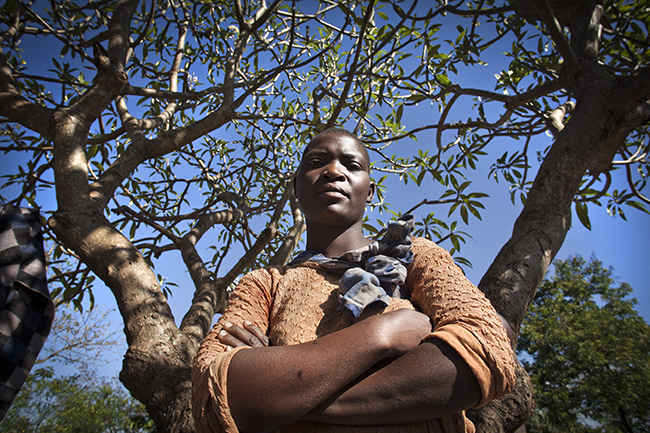
Jennifer is a mother of four and a patient in the PMTCT program in Thyolo, Malawi. Photo by Sydelle Willow Smith
A newer alternative, Option B+, is gaining greater acceptance. It was recommended by the WHO as the best course of treatment for pregnant women in 2013. Option B+ was devised in Malawi, a country with limited access to CD4 lab testing. Designed to simplify and broaden PMTCT services, it calls for putting all pregnant women who test positive for HIV on an ART regimen right away, regardless of their CD4 count, and for keeping them on ART for the rest of their lives.
There are several potential advantages to the B+ approach. It is easier for the mother to take a tablet once a day than trying to get a young baby to take a syrup every day, as they must with Option A. What’s more, if the mother remains in treatment, any future pregnancy is protected as long as the level of HIV in her blood remains low. The ART also provides health benefits for the mother herself. And since we now know that effective ART can render the amount of the virus in someone’s blood and sexual secretions to be almost undetectable, it makes it that much more difficult to transmit HIV to one’s spouse, partner—or baby during pregnancy and breastfeeding.
MSF is unable to guarantee lifelong ART in all of its PMTCT projects. Where national governments have not instituted a consistent system of care for HIV patients, those initiated on antiretroviral treatment have nowhere to go after PMTCT with MSF is complete. Most often the developing countries with the highest rates of HIV are the only ones that have established such a system, so MSF is limited to using Option B+ in countries with a high prevalence of the disease. Malawi, Swaziland, Zimbabwe and Lesotho are four examples, and in each, Option B+ is also part of the national treatment protocol.
Option B+ is extremely promising, but it is not a cure-all and it cannot end mother-to-child transmission by itself. Over the years, I have met women who have refused to start treatment—or defaulted on it once they began—because they were financially and socially dependent on their partners and feared that disclosing their HIV status would have disastrous consequences. Some have, amazingly, overcome these barriers, but others have not, and have suffered the inevitable outcome.
For those who are able to reach our treatment facilities, we have to make sure that we take into account the patient and the realities of her life. As Julia and many others have shown, women with HIV still have a great deal to live for.
Whatever It Takes, We Should Do
By Pamela A. Onango, RN, Midwife
In 2014, when I was working in Agok, South Sudan, I had a displaced, pregnant 26-year-old patient named Amal. She had come for antenatal care, which includes testing for HIV. She was very receptive to the health information, the explanation of what HIV is, and how it is treated. She was cooperative during the testing, too. But when I presented her with the results of her HIV test and told her that she had tested positive for the disease, she said, “No, it is not mine.”
There were only the two of us in the consultation room. I had clearly drawn and tested her blood. I told her that yes, her result was positive for HIV, but she still would not accept it.
We decided to give her some time to think about it. In this project, we track all our patients. If someone does not come for follow-up, we reach out to them and ask them to come back, and we kept reaching out to her. She kept denying that she was HIV positive. She kept insisting that she couldn’t be sick, she couldn’t have the disease. We kept trying to convince her to get PMTCT treatment—if not for her own sake, than for the sake of their baby. But we were not successful.
Testing is usually not the challenge;
the challenge comes when we have the results.
Every patient needs to understand what it means
to have HIV and be on antiretroviral treatment.
Amal delivered at home, without having had any PMTCT care. We asked her to come for post-natal care where she would receive incentives like a mosquito net, a luxury in a camp in Agok. We still could have given the baby medication and Amal would not have had to take anything herself if she did not want to. But that would have been admitting she was sick and she could not do that.
It was very sad for us, for her baby, and for her. The baby could become symptomatic in the first few years of his or her life and could die; Amal, too, could die as a result of her infection.
Testing is usually not the challenge; the challenge comes when we have the results. Every patient needs to understand what it means to have HIV and be on antiretroviral treatment. Many will grasp this only after extensive counseling, which takes time, because it’s not always easy for people to accept the new reality and adjust to its ramifications for them and their families. Perhaps additional counseling could have helped Amal realize what needed to be done for her and her baby. A community better informed about HIV and treatment options would have helped as well.
I’ve worked in places with very high HIV prevalence rates, like Swaziland, where in 2012 more than a quarter of the general population was living with HIV, and where surveys conducted two years earlier had found that 41 percent of pregnant women were as well.vi The numbers are staggering, but many people in the country understand what HIV is and what can be done about it. In contrast, South Sudan’s prevalence rate was estimated at 2.3 percent in 2013. Far fewer people were living with the virus, but also far fewer who knew what it was.vii
“I went to the doctor because I was suffering from enlarged lymph nodes on my neck. The hospital was screening everyone for HIV and that is how I found out I was HIV-positive.
When I got my results I was shocked. I went home and stayed there. I did not go out.
Eventually I learned about a local NGO and they gave me information about MSF. That is how I came to this clinic. The MSF staff asked me to bring my partner to the clinic to get the HIV test as well. My husband tested positive, too. His CD4 count was very low—180.
Eight months later I found out I was pregnant. I didn’t get out of bed. I stopped eating and lost weight. I was so anxious and worried about my baby. But I talked with my husband and we went together to the MSF clinic to find out what could be done.
We got counseling and talked to the doctors. I got information on how to reduce the risk of transmission to the baby and that helped me calm down.
If I had not gotten this information, I know I would have stayed home and my child would have gotten infected with HIV.
I have not disclosed my status to my family, only my husband. I think they would discriminate against me. I see a lot of discrimination in my community. If someone has HIV, no one visits that house. A girl with HIV died recently and no one in the community went and helped with her funeral.
I don’t know if she did not get treatment because she didn’t have any information or because she blamed herself and was in denial. It could have been either.
It takes me three hours to reach the clinic every time I come. I take a boat across the river, then a bus, to get here. But other patients have to come from even farther away. My only concern is for how long MSF will be able to provide me with antiretrovirals.”
In both situations, there are opportunities to provide effective PMTCT. When there is already some understanding of what HIV is, it is easier to counsel mothers, to make them understand that there is treatment available, and advise them how to live a healthy life and protect their babies. I have seen mothers go to incredible lengths to protect their children, but there are many obstacles to proper care, including the stigma that still attends the disease.
In a country like South Sudan, there is a great opportunity to give people the right information about the disease and the treatment for it. But with no foundation of understanding and acceptance in the community, and no political willingness to deal with HIV at the policy level, misinformation spreads and people struggle to accept HIV and the importance of starting ART. I’ve seen community leaders say, “I have heard about HIV, but we don’t have that in this country.” It’s not so different from Amal’s refusal to accept her status.
Sometimes fears surround the medication; people worry that it is toxic or will affect one’s features so that others will recognize that they have HIV. (This relates to old treatments that disfigured the face and muscles. With the newer regimens this does not happen.) MSF projects, therefore, stress community outreach and education. During the daily general health talks we give at MSF hospitals, our staff try to educate all patients about HIV. We also hire and train community health workers to visit people in their homes and in public places to raise awareness about HIV.
In Swaziland, a patient named Elizabeth came to us from outside the Nhlangano region. She was open about her status and, having already been through a PMTCT program elsewhere, she knew all about HIV treatment. Her CD4 count was still high, but she came to us during her second pregnancy because she wanted lifelong ART and had heard that MSF was running a pilot project in Nhlangano using Option B+. “I want to remain the way I am now and I am told that when you take this treatment you will not be sick with other diseases,” she said. “And, one thing I am certain of is this will not be the last time I am pregnant.”
Though she lived far away, Elizabeth stayed near the hospital to get treatment until she delivered. After that she was transferred back to her health zone and continued treatment. Her understanding of the disease and her determination to live to the fullest pushed her to seek out a treatment strategy that worked for her and her children. We also asked her to bring her husband for testing. They hadn’t been married long and she hadn’t told him she had HIV. As it happened, he had it, too, and he had been on ART for years.
Many women are scared to tell their husbands they have HIV,
and many husbands refuse to get testing or treatment for themselves
or to take steps necessary—including using condoms—to protect their spouses,
and thus their children, from HIV.
This was a good outcome, leading to a better understanding among partners who learned the other was dealing with more than they would have imagined. Research has shown that a woman who has told her partner about her status is more likely to come for follow-up care. But in many cases, it does not go so smoothly. Many women are scared to tell their husbands they have HIV, and many husbands refuse to get testing or treatment for themselves or to take steps necessary—including using condoms—to protect their spouses, and thus their children, from HIV.
An intransigent or willfully ignorant partner can be a major obstacle for both treatment and prevention. I have had numerous patients tell me that they must “get consent” from the husband before making any decisions about starting ART. Sometimes I want to say, “Why are you asking your husband for permission to live?” Either they truly are not allowed to make these decisions or they are making an excuse to avoid a decision. In either case they clearly feel they lack the power to make it and that is a very big challenge.
“There is always blame for you as an HIV-positive woman. We try as much as we can to change that attitude.
I talk in the community, in churches, in mosques, in women’s groups, and schools to educate people. First, I tell them about taking the HIV test. When I was tested 10 years ago, the counselor told me I only had six months to live. Within those six months there would come a time when I would get very sick and die. But now I am giving people hope. I tell them we have hope because nowadays we have ARVs [antiretroviral medicine].
Having HIV is more accepted now because we have gotten the community leaders engaged. We have the teachers, the religious leaders, and business community leaders.
We trained them first on what exactly it means when a person is HIV-positive. That’s how we’ve gained acceptance. It’s through talking and training people.
With the husbands, it is still a challenge. Women will come get tested. When you tell them to go and disclose their status to their husband, most of the women will say no. So we encourage women to come get tested again with their spouse. If they come in together we act as if it is the first time we have seen them and test them both.
For health education we encourage men to accompany their pregnant wives to antenatal check-ups. We don’t miss the opportunity to get couples together. Today we have two couples and we are giving them priority.
We know when they go back home they will talk to people who will also come. That is the strategy. When someone comes for ANC [antenatal care] or vaccination with their spouse we give them priority. Now you will find men who ask permission from work to accompany their wives to the clinic.
It used to be, you would see people in Kibera [a poor neighborhood in Nairobi, Kenya] who had really deteriorated. Now you will not find people with full-blown AIDS because there is treatment available. There is more acceptance in the schools now, too. We as people with HIV are ambassadors and our goal is to break down stigma in the community.”
Women need their partners’ support, but men are not customarily involved in PMTCT. Men have pointed out to me that the name PMTCT includes the word mother but not father. “How are we involved in this?” they say. “If the mother wants the program, let the mother handle the program with the baby.” They also tend to see the maternity department and antenatal care area as women’s or children’s places, so they don’t think they should come in to be tested with their partner.
MSF is trying to change some male attitudes towards HIV and testing prevalence in places where we work. It’s not so much a social issue for us as a medical one, a recognition that certain behaviors have profound public health consequences—especially for women and children. Right now in Gutu, Zimbabwe, for example, MSF teams are keeping the clinic open at night, when men seem to be more willing to come in, and getting patients who test positive on treatment immediately. So far, 70 percent of those tested have been men.
We also need to encourage men to be more involved in PMTCT. I wonder if we should call it Prevention of Parent-to-Child Transmission, to make it more inclusive. We should do whatever it takes to remove these challenges and get more women (and men) in treatment.
A Shift in Thinking and Treating
By Joanne Cyr, Psy.D.
Sylvia came into our counseling room at Arua Regional Referral Hospital in Uganda one afternoon, carrying her three-month-old baby. She had previously tested positive for HIV and was on ART to prevent her from transmitting the virus to her child, according to the PMTCT Option A approach. She had been bottle-feeding the child with something—cow’s milk, perhaps. In this area of scarce food, most women would not have had access to alternatives to breast milk.
This was in 2011 and the health staff were strongly encouraging women, including those living with HIV, to breastfeed their babies exclusively. Breastfeeding provides a child with rich protective immunoglobulins and nutrients that they will not get from any other source. It’s not always obvious to young mothers, though, and they need support and guidance. It was all the more distressing when the health ministry nurse and midwives at the hospital openly disparaged Sylvia’s decision to not breastfeed. In response, I met with Sylvia and introduced her to the “peer mothers,” a group of three women MSF had hired and trained as peer counselors. They were members of our PMTCT Mothers Support Group and had already been through the PMTCT program. MSF uses “expert patients” like these women in many different projects. They are able to help guide women like Sylvia through the same difficult journey they had made.
Peer mothers are able to use their own experience
and take into account mothers’ personal fears and history.
They add a much needed personal element to a clinical setting.
In Arua, the peer mothers worked closely with the patients from diagnosis to delivery and after. Two peer mothers taught daily health education at the hospital and offered one-on-one support. Another, Jane, was in the antenatal room where the ministry of health staff offered routine HIV testing. She would speak with women who were being tested and spent extra time with those who tested positive. She would also offer to accompany them to the PMTCT clinic for education and enrollment.
The peer mothers told Sylvia how they had breastfed their own babies, who were still free of HIV. In talking with her further, however, Jane discovered that Sylvia was deeply afraid that she might infect her baby through breastfeeding, even if she followed every guideline we gave her. Jane also learned that Sylvia was an educated woman who knew a lot about HIV and that she could afford to buy formula. In the end, the peer mothers helped Sylvia make an informed choice to bottle-feed her baby with formula safely, without any other foods that could put the child at risk.
Peer mothers are able to use their own experience and take into account mothers’ personal fears and history. They add a much needed personal element to a clinical setting.
At nine months old, Sylvia’s baby tested negative for HIV. I helped the doctor deliver the news, and Sylvia expressed gratitude to the entire team for their support.
In 2013, when MSF was launching a PMTCT Option B+ pilot program in Nhlangano, Swaziland, I met Trinity, an exceptionally skillful peer counselor living with HIV who was trained by the South African peer support organization Mother-to-Mother. She helped us refine our patient information messages for the launch and helped counsel mothers in the program. I was lucky enough to see her in action one day.
The nursing staff had just diagnosed as HIV-positive a patient who was six months pregnant and sitting with her two-year-old on her lap. Trinity immediately joined her and delivered just the right amount of information, reassurance, and recommendations. I suggested that she accompany the mother to the nearby health center to have an antenatal care exam and get a prescription for antiretrovirals, and she agreed.
Trinity helped the woman formulate a plan to disclose her status first to her sister-in-law, and then to her partner. Her partner agreed to come in for testing, along with the two-year-old. He tested positive; the toddler was negative. Trinity counseled the couple together and got them started on taking lifelong ART.
“I am 14 years old and I have one child, a son. I went for an antenatal check-up at the health center. They tested me and told me I am HIV-positive, the virus that causes AIDS.
They told me they were going to give me medication, but since I am a minor I had to go get my parents. I asked my parents to go with me to the health center and they refused, so I asked my elder sister. She’s the one who allowed me to start my antiretroviral therapy.
My mother said that since she was not there when I got HIV, it should not affect her. I felt bad. I felt this is not like my mother. It affected me. It really hurt. Sometimes the family wouldn’t give me food to eat. Sometimes I had to sleep outside the house. My mother would take the flour bucket and hide it so I could not eat at all.
My sister supported me the way I needed, but the rest of the family did not help me at all. My mother and I are still not on very good terms.
As of now, my son is HIV-negative. I thank God for the help I receive every time I go to the PMTCT program. I think other girls can benefit from the counseling as I did, if they are open enough to go to the health facility to get it.
What I’m planning for the future is to get my son tested again at 24 months. When I confirm it’s negative, I will look for work, even for housework. What I need is money to support my son.”
Even with peer mothers’ involvement, programs offering integrated HIV and maternity care face significant challenges, much of them related to limited human resources. Patients do not always get the confidential space they need in this environment, although privacy and confidentiality are an essential part of PMTCT. I’ve even seen women being tested for HIV in front of other women in the waiting room. Men who come in with their partners will usually refuse to get tested in this situation.
What’s more, women often do not get proper counseling. In my training sessions I’ve asked for feedback from staff working in these projects and have been told that proper counseling takes too long when they have 30 other women who need testing and counseling as well. We talk about this a lot, and the point I try to drive home is that if you counsel a woman properly, she will be more of an agent in her own health care over the long term—she can make informed decisions and stick with the decision she makes. She can also develop skills for discussing health issues with her partner.
This is the essence of patient-centered care, but it’s an approach that takes time to instill. Staff in HIV programs must follow national or other guidelines that are by necessity very regimented and clear-cut. There is not a lot of room for making individual assessments. Asking people to use their clinical or personal judgment, and to make decisions based on the needs of the individual patients involves asking them to adapt. It’s a big shift, but it’s a necessary one. A health worker has to be able to take in a patient and her personal circumstances regarding her family and community, her strengths, vulnerabilities and particular challenges, and help her accordingly.
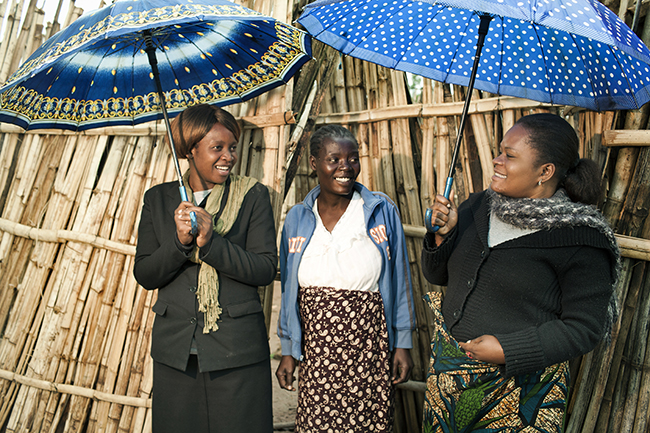
In Malawi, Rose, center, stands with two peer mothers who helped her through the challenges of getting on antiretroviral treatment and working to keep her baby HIV-free. Photo by Sydelle Willow Smith
Treatment for HIV has come a very long way in the last two decades, but the fight is not over. The availability of affordable generic antiretrovirals in developing countries since the 2000s has saved countless lives. Prevention of the transmission of the disease from mother to child has also taken leaps forward, especially with the advent of Option B+. But even today, many people who need ART are not receiving it, and Option B+ needs to be available in more countries, including those that do not have high rates of HIV, to better protect the next generation and their mothers.
A major battle must be won against the stigma that still surrounds HIV, which prevents women, pregnant or otherwise, from getting treatment. The stigma prevents men from supporting or even allowing their partners to gain access to treatment (and keeps men from getting tested and started on treatment). More governments and communities need to take the lead in combating misinformation and stigma around HIV. Health care providers must engage men as much as possible in PMTCT, to strengthen their support.
Finally, peer mothers or expert patients are invaluable in PMTCT programs for the empathetic individual counseling they provide, among other reasons. They should be closely involved in care every step of the way. But given the sensitivity around HIV, staff members providing clinical care must also take into account individual needs, even if they feel overwhelmed by their workload. Women need discreet, supportive and responsive care. This is another challenge that will take time and a lot of reinforcement, but it must be done to get results.
In many instances, a woman who tests positive for HIV will immediately ask, “Am I going to live?” The very next question is often, “Can I raise a family?” Health care staff have to be ready to help every woman through these questions and those that follow. Her treatment, her future, and the futures of her children depend on it.
*All patient and staff names have been changed.
iWorld Health Organization. Mother-to-child transmission of HIV. http://www.who.int/hiv/topics/mtct/en/
iiUNICEF. The First Decade of Life. Updated 2013; http://www.unicef.org/aids/index_firstdecade.html
iiiUNAIDS. Epi Slides, p. 20. http://www.unaids.org/sites/default/files/media_asset/01_Epi_slides_2014July.pdf
ivUNICEF. Towards an AIDS-Free Generation-Children and AIDS Stocktaking Report. 2013, p. 2. http://data.unicef.org/corecode/uploads/document6/uploaded_pdfs/corecode/str6_full_report_29-11-2013_78.pdf
vWorld Health Organization. Global Update on HIV Treatment: Results, Impact and Opportunities. 2013; http://www.who.int/hiv/pub/progressreports/update2013/en/
viUNAIDS. Swaziland Country Report on Monitoring the Political Declaration on HIV and AIDS. March 2012.
http://www.unaids.org/sites/default/files/en/dataanalysis/knowyourresponse/countryprogressreports/2012countries/ce_SZ_Narrative_Report[1].pdf
viiSouth Sudan HIV/AIDS Commission, UNAIDS. Global AIDS Response Progress Report, Country: South Sudan. March 2014. http://www.unaids.org/sites/default/files/country/documents/SSD_narrative_report_2014.pdf



